TORONTO - With the weight and size restrictions for carryons and checked luggage, travelling with camera gear has become increasingly challenging. The good news: there is a variety of high-quality yet inexpensive gear that ease the burden of packing while providing amazing versatility in the images you can capture.
On a recent trip to India with Bestway Tours & Safaris, I restricted myself to a minimum gear setup that I could easily pack in a light shoulder pack, along with my usual carryon items of laptop, backup drive, headphones, iPad and other travel accessories. I planned to be on the road for almost four weeks, with numerous flights, both internationally and domestically, so carryon weight was at a premium.
I chose to use my Nikon D750 with an AF-S NIKKOR 28-300mm f/3.5-5.6G ED VR, the Nikon Df with a NIKKOR 50mm f/1.8, and the mirrorless Nikon 1 V3 with its 10-30mm, 10-100mm and 10mm f/2.8. This provided me with a complete range of lens choices, low-light flexibility and also backup bodies — just in case. Two SB910 flashes provided remote TTL flash options and a backup if needed. I also packed a travel transformer and power bar to make charging everything easy to do, in minimal time.
Lenses: Keeping It Simple
Over the four weeks, I never changed the lenses on the DSLRs. The 28-300 range was fabulous on the D750, and the Df/50mm combo became my low-light setup for nighttime extreme image creations. I packed a tripod, but only used it twice as the high ISO capability (which I used up to 12,800 ISO) overcame the shutter speed requirements, and the tripod was impractical to carry most of the time.
I discovered that the D750 with 28-300 appeared impressive to passersby; when people saw it, they were happily willing to pose for me, or to let me through to the front of a crowded location. The Nikon 1V3 setup was wonderful when I wanted to be as unobtrusive as possible. In the lowest light conditions, the Df with the 50mm never failed to provide instant autofocus and amazing image quality.
Aside from never missing a shot, another benefit of not changing lenses was that despite the dusty and harsh conditions I was shooting in, the chance of sensor dust and general cleaning needs were kept to a minimum. Going from 18C in an air-conditioned interior to 40C outside can be hugely problematic with condensation, so changing lenses would have needed to be done with extreme care — not to mention the time I would have wasted waiting to do it.
Taking the Shot
My general shoot style is to use Aperture Priority for exposure, with ISO typically set between 800-4000 and up to 12,800 as needed. The built-in VR on the 28-300 allowed me to hand hold comfortably at 1/125th without concern when zoomed in at 300mm, or even down to 1/8th if I was careful. I like to use apertures that are wide open, which allows my backgrounds to fade back in detail so as to be less distracting, but still provide context and storytelling elements.
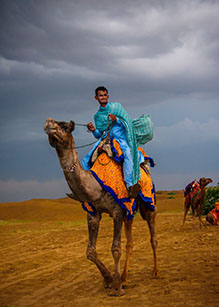
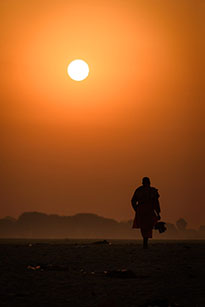
Left: Our camel trek was cut short by an evening thunderstorm, which provided an amazing light opportunity to work with in this portrait of one of the guide. Right: Sunrise over the Ganges River, looking across the sandbar to the opposite shore as a man walks with his container of holy water drawn from the river.
While shooting travel imagery, the biggest tip I can offer is to always be ready, as you never know what is going to appear around the corner, or whom you may come across at any moment. Light conditions will change constantly from bright sunlit, to shade, to darker covered over areas, resulting in the need for various exposures. Using aperture preferred auto and a slightly higher ISO for comfortable handheld shutter speeds will go a long way to ensuring you never miss a shot by blowing the exposure, or fussing with your camera settings.
When approaching a new area to photograph, light opportunities should always be your prime motivator. Look for pockets of light, interesting shadows and shapes, and try to position yourself to allow the light to come from the sides and “into your subject,” rather than from behind you. This is a big part of how to be successful in adding interest and depth to your images.
Photographs that make use of strong graphic colour, silhouettes, inclement weather, unusual camera angles, and even signage that’s humorous can add a powerful impact to your image collection and presentations.
Of prime importance is to tell the story within an image by composing it to include the background and with the subject, usually off centre and to the side. In a series, always try to capture a wide-angle perspective along with close-ups, something very easy to do with the zoom range of the 28-300.
Using motion within an image can be very powerful in telling the story, and with a bit of practice, can be a highly successful tool. Making use of a slower shutter speed while panning along the same plane of your subject’s motion is a great technique to use while looking for the “peak action.” That fraction of a moment when the subject has stopped his or her direction of movement is another.
Subjects: People, Places and More
Asking permission before photographing someone is respectful and always encouraged. It rarely meets refusal, is very easy to do once you get used to it, and also allows for a much more engaging interaction between you and your subject. As well, taking an extra moment and looking for a few additional frames after your “thank you” can often provide bonus images that appear more natural.
While photographing kids, especially with language barriers, taking the time to really smile, say hello, and to crouch down to their level, almost always results in rewarding expressions in return.
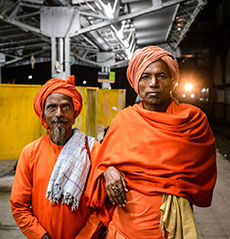
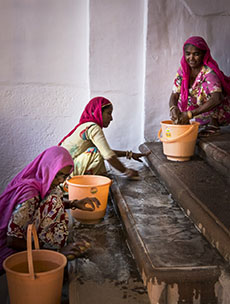
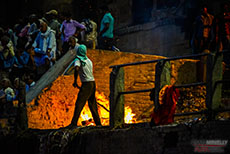
Left: Orange robed nomadic priests, ahead of the incoming night train from Agra to Varanasi. They were happy to present their portrait pose for me. Middle: The subtlety of the compact mirrorless camera is perfect for capturing natural moments of all kinds. Here a trio of women scrub the steps of the Mehra. Right: A worker, covered from the heat, tends to one of the many cremation pyres that burn 24/7, year round at the Manikarnika Ghat in Varanasi, India.
An important consideration when interacting with local people is that every culture has its own traditions. For example in India, a side-to-side nodding of the head is their typical way of saying “okay,” which is very similar to the side-to-side turning of the head meaning “no” that we’re more familiar with. (As it took me a couple of days to realize this, I’m sure there were a few confused people that wondered why I didn’t take their picture after they had said I could.)
Buildings and architectural features provide amazing settings for people subjects, and often add an intriguing graphic element to the moment. Showing repetition in form with telephoto settings, using windows and walkways to frame subjects, and showing depth and perspective with wide-angle techniques are all composition opportunities to continually make use of.
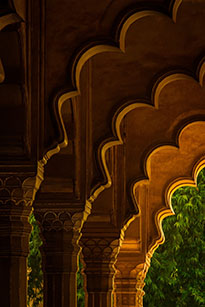
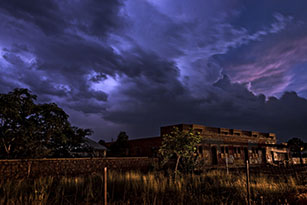
Left: Stacked architectural features of the Red Fort in Agra at sunset, making use of the compression created with the telephoto zoom at 300mm. Agra, India. Right: Staying barely ahead of the rain, we pulled over at an abandoned roadside building to create a 25-second time exposure of the dramatic night sky.
Having a minimal camera outfit, and not having to think about lens swaps or changing exposure setups, really simplifies the overall photo process. The best part about these gear setups, camera settings and compositional suggestions are that they are all easy and don’t detract from the travel experience.
I’m a firm believer that you should always first strive to enjoy the travel opportunities as they happen, without being gear loaded with tech distractions. That way you can truly savour the moment with the images that you do capture becoming that much more powerful as part of the storytelling memories you create and are able to share with others!